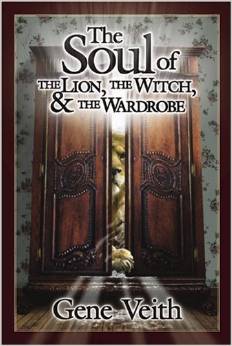Gene Veith: The Soul of the Lion, the Witch, and the Wardrobe
 Gene Veith, The Soul of the Lion, the Witch, and the Wardrobe (Colorado Springs: Cook Communications Ministries, 2005), 206 pages.
Gene Veith, The Soul of the Lion, the Witch, and the Wardrobe (Colorado Springs: Cook Communications Ministries, 2005), 206 pages.
In the preface to the book, Veith sets forth the premise that his book is intended to be a companion volume to Lewis’ work, originally written for children, that “will help you unpack the meaning of the story.” It also shows how Lewis’ book fits in with the whole heritage of Christian literature, particularly that form to which many Christian writers have gravitated: fantasy. Veith’s book is divided into two parts in accordance with these premises. Veith contends that his book can be read in the way that books are normally read or simply used as a resource. My impression is that the book is best when read in the normal manner.
Veith shows a great depth of understanding of literature, especially as it relates to the Christian faith, which I personally found to be quite educational. The book also reflects that Veith himself is well grounded in the Scriptures and has a solid evangelical understanding of the Christian faith. Veith also adroitly deals with the use of the imagination to communicate divine revelation. Some people, according to Veith, question the legitimacy of this method of communication. Veith citing Hebrews 11:1, and the reality that the Bible makes ample use of narrative and poetry.
Veith regards Lewis as a master of the fantasy genre, especially given Lewis’ background as a literary expert. The use of fantasy requires the ability to express thought in vivid, concrete images that stimulate the use of the imagination. To explain how Lewis uses fantasy so well, Veith uses several pages to tell the gist of the story of The Lion, The Witch, and the Wardrobe for those who may not have read it, or who may have read it so long ago that they have forgotten it. In doing so, Veith explains that in order for Lewis to help children apply the truths learned in their lives, the story must be anchored in the real world. In The Lion, The Witch, and The Wardrobe, the setting is the Battle of Britain in World War II. This part of the story, Veith notes, may be somewhat autobiographical, as Lewis himself protected children during the Nazi Blitz at his home outside of London. It may be that he saw himself in the character of the old professor.
Narnia, as Veith points out, is rich in symbolism, especially as revealed in its characters. Lewis, according to Veith, intentionally used the symbolism to communicate biblical truths. Aslan clearly symbolizes Christ while his archrival, the Wicked Witch, clearly demonstrates some of the characteristics of Satan. The story, then, is a fantasy clearly written within the biblical paradigm of good and evil with human beings, in this case, Peter, Susan, Edmund, and Lucy, in the center of the drama. Humans are portrayed here as free moral agents who are the objects of Aslan’s love and the Witch’s wrath, who are called upon to choose whom they will serve. Veith rightly regards Lewis as a deft theological.
In the second part of the book, acknowledging that fantasy has become an extremely popular reading genre, he compares Lewis to J.K. Rowlands’ Harry Potter series and His Dark Materials, another series of books by Philip Pullman. While I have not read any of the Potter books and have never heard of Pullman’s series, I am quite familiar with the tenets that underpin witchcraft, which permeates the Potter books, and well understand the justified reasons why Christians should be concerned about such practices. Veith notes that children in particular have been drawn to the Potter series, finding it to be a great read. His conclusion is that the best antidote to the theological errors in Harry Potter is to not only solidly ground children in the reality of the Word of God but to also expose them to good fantasy literature such as The Lion, The Witch, and the Wardrobe.
Category: Living the Faith


